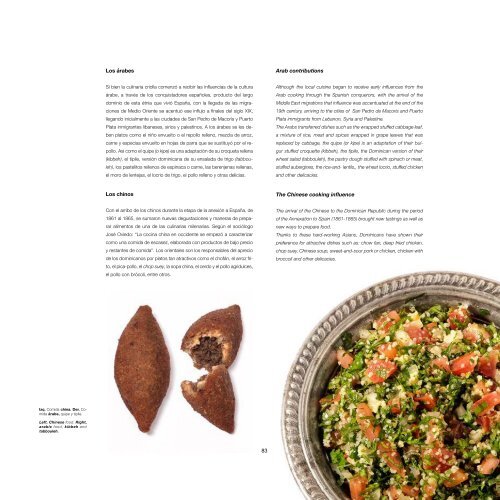Sabores-Ancestrales-Digital-1
Create successful ePaper yourself
Turn your PDF publications into a flip-book with our unique Google optimized e-Paper software.
Los árabes<br />
Arab contributions<br />
Si bien la culinaria criolla comenzó a recibir las influencias de la cultura<br />
árabe, a través de los conquistadores españoles, producto del largo<br />
dominio de esta étnia que vivió España, con la llegada de las migraciones<br />
de Medio Oriente se acentuó ese influjo a finales del siglo XIX,<br />
llegando inicialmente a las ciudades de San Pedro de Macorís y Puerto<br />
Plata inmigrantes libaneses, sirios y palestinos. A los árabes se les deben<br />
platos como el niño envuelto o el repollo relleno, mezcla de arroz,<br />
carne y especias envuelto en hojas de parra que se sustituyó por el repollo.<br />
Asi como el quipe (o kipe) es una adaptación de su croqueta rellena<br />
(kibbeh), el tipile, versión dominicana de su ensalada de trigo (tabbouleh),<br />
los pastelitos rellenos de espinaca o carne, las berenjenas rellenas,<br />
el moro de lentejas, el locrio de trigo, el pollo relleno y otras delicias.<br />
Although the local cuisine began to receive early influences from the<br />
Arab cooking through the Spanish conquerors, with the arrival of the<br />
Middle East migrations that influence was accentuated at the end of the<br />
19th century, arriving to the cities of San Pedro de Macoris and Puerto<br />
Plata immigrants from Lebanon, Syria and Palestine.<br />
The Arabs transferred dishes such as the wrapped stuffed cabbage leaf,<br />
a mixture of rice, meat and spices wrapped in grape leaves that was<br />
replaced by cabbage, the quipe (or kipe) is an adaptation of their bulgur<br />
stuffed croquette (kibbeh), the tipile, the Dominican version of their<br />
wheat salad (tabbouleh), the pastry dough stuffed with spinach or meat,<br />
stuffed aubergines, the rice-and- lentils,, the wheat locrio, stuffed chicken<br />
and other delicacies.<br />
Los chinos<br />
The Chinese cooking influence<br />
Con el arribo de los chinos durante la etapa de la anexión a España, de<br />
1861 al 1865, se sumaron nuevas degustaciones y maneras de preparar<br />
alimentos de una de las culinarias milenarias. Según el sociólogo<br />
José Oviedo: “La cocina china en occidente se empezó a caracterizar<br />
como una comida de escasez, elaborada con productos de bajo precio<br />
y restantes de comida”. Los orientales son los responsables del aprecio<br />
de los dominicanos por platos tan atractivos como el chofán, el arroz frito,<br />
el pica-pollo, el chop suey, la sopa china, el cerdo y el pollo agridulces,<br />
el pollo con brócoli, entre otros.<br />
The arrival of the Chinese to the Dominican Republic during the period<br />
of the Annexation to Spain (1861-1865) brought new tastings as well as<br />
new ways to prepare food.<br />
Thanks to these hard-working Asians, Dominicans have shown their<br />
preference for attractive dishes such as: chow fan, deep fried chicken,<br />
chop suey, Chinese soup, sweet-and-sour pork or chicken, chicken with<br />
broccoli and other delicacies.<br />
Izq. Comida china. Der. Comida<br />
árabe, quipe y tipile.<br />
Left. Chinese food. Right,<br />
arabic food, kibbeh and<br />
tabbouleh.<br />
83


